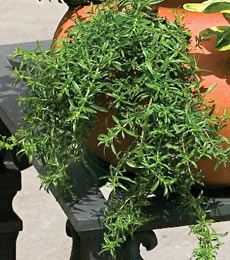TIP OF THE DAY: A Pot Of Savory
| The last in our series of herbs is savory, a member of the mint family. Savory leaves have strong spicy, peppery flavor and mix well with other herbs.
The flavor of savory is so bold and peppery that the Saxons designated the entire category of spiced foods as “savory,” and the word became synonymous with flavorful foods. Savory is used as a blend in herbes de Provence, and is part of the Arabic spice mix, za’atar. There are some 30 species of savory, but the two that are valuable as culinary herbs are summer savory and winter savory. Summer savory, an annual, is better known and has more tender leaves; winter savory, a perennial, is easier to grow, stronger in flavor and better for long cooking (beans, soups, stews) due to its coarser leaf. |

Winter savory available from WhiteflowerFarm.com. |
|
| Savory is a versatile herb; chefs call savory a great mixing herb. It blends well with basil, oregano and thyme, especially in fish, meat and poultry dishes. Add it to chicken salad (one teaspoon freshly minced), marinades, meat loaf, meatballs, turkey burgers and stews. Season your stuffing with a mix of bay leaf, sage, savory and thyme.
Try savory with legumes (green beans, dried beans and lentils), cabbage and sauerkraut, soups and succotash. Add some leaves to salads, pizza and sauces. FOOD HISTORY: The Romans used savory before they had pepper (which came from India), and considered it an aphrodisiac. Savory vinegar was a popular Roman condiment. During a World War II pepper shortage in Germany, they used savory for a peppery flavor in their cuisine.
|
||


